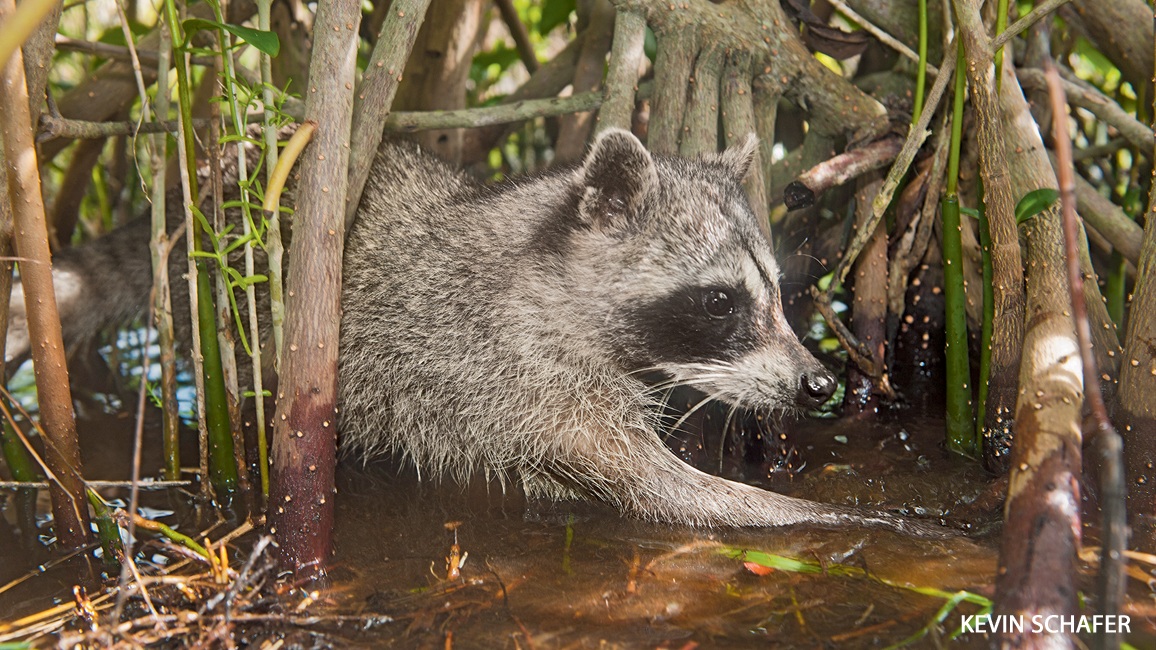
Pygmy Raccoons
By Anne Cissel; photos by Kevin SchaferMeet Ranger Rick’s tropical cousins that need a helping hand to survive.

The pygmy (PIG-mee) raccoon looks a lot like the raccoons you might see in your neighborhood. Check out that dark mask around the eyes. It’s also got a pointed, whiskered nose and a long, striped tail.
One big difference is right there in its name. “Pygmy” means small, and this type of raccoon is about half the size of the kind that lives in the United States. Also, in the picture, you can spot another difference: It sports a reddish tail.
But what really sets pygmy raccoons apart is how rare they are. Millions of the larger raccoons live in the United States. But there are only around 300 pygmy raccoons left in the wild. And they all live on Cozumel (koh-zuh-MEL), an island off the east coast of Mexico (see map above). Keep reading to get a closer look at these cute island mammals.

ISLAND LIFE
Tourists flock to Cozumel to enjoy the beautiful beaches. But most vacationers don’t realize that pygmy raccoons live on the island, too.
A pygmy raccoon weighs between 6 and 9 pounds—about the same as a newborn human baby! These small mammals hunt in sandy wetlands or in mangrove swamps. (Mangroves are tropical trees that grow in salty water.) Though the raccoons eat fruits, leaves, lizards, frogs, and insects, they love crabs the most. Pygmy raccoons are nocturnal (nok-TUR-nuhl), which means they’re active mainly at night. During the heat of the day, they rest up in trees.
Like all raccoons, pygmy raccoons are expert climbers. What makes them so good? It’s all about those front paws. The word raccoon comes from a Native American word that means “animal that scratches with its hands.” In fact, a raccoon’s unusual front paws are a lot like people’s hands. Each paw has five long “fingers” with claws that give the animal a firm grip. That grip is not only great for climbing but also for prying crabs out of their shells.
The paws’ padding gives the animal a strong sense of touch. A raccoon can feel things so well that its paws are almost like a second set of eyes. Scientists have discovered that raccoon paws are even more sensitive when wet. This is why you sometimes see raccoons “washing” their food. They aren’t really washing it; they are “looking” at it more closely.

CHALLENGES
Cozumel may be paradise for tourists, but, for pygmy raccoons, life is no picnic. In fact, the little animals are critically endangered. People keep building more resorts on the island, destroying the forests and wetlands. Trash and other pollution damage the land that is left. Sometimes, when the raccoons try to cross the island’s roads, they are hit by cars and trucks. Because people feed them, the raccoons have become fearless and beg for food. But human food isn’t healthy for the raccoons.
Animals that don’t naturally belong to the island also threaten the raccoons. Large snakes called boa constrictors were set free there, probably by people who no longer wanted them as pets. The snakes can now be found all over the island, and they eat the raccoons! Also, pet cats and dogs that have become feral, or wild, roam the island and spread diseases to the raccoons.
PEOPLE HELPING
There are many different ways people are trying to help pygmy raccoons. One way is by keeping some areas of the island wild. The people of Cozumel have also passed laws that protect the raccoons and other island wildlife.
One of the most important ways to help the pygmy raccoons is by teaching local people about them. Because the pygmy raccoons look so much like the bigger, more common raccoons, some people assume there are plenty of them. People also might think of them as pests when the raccoons get too close to homes and businesses. Scientists are spreading the word about the dangers the raccoons face. The more people learn about these special creatures, the more likely they are to want to save them. And that is good news for our furry little friends!
















